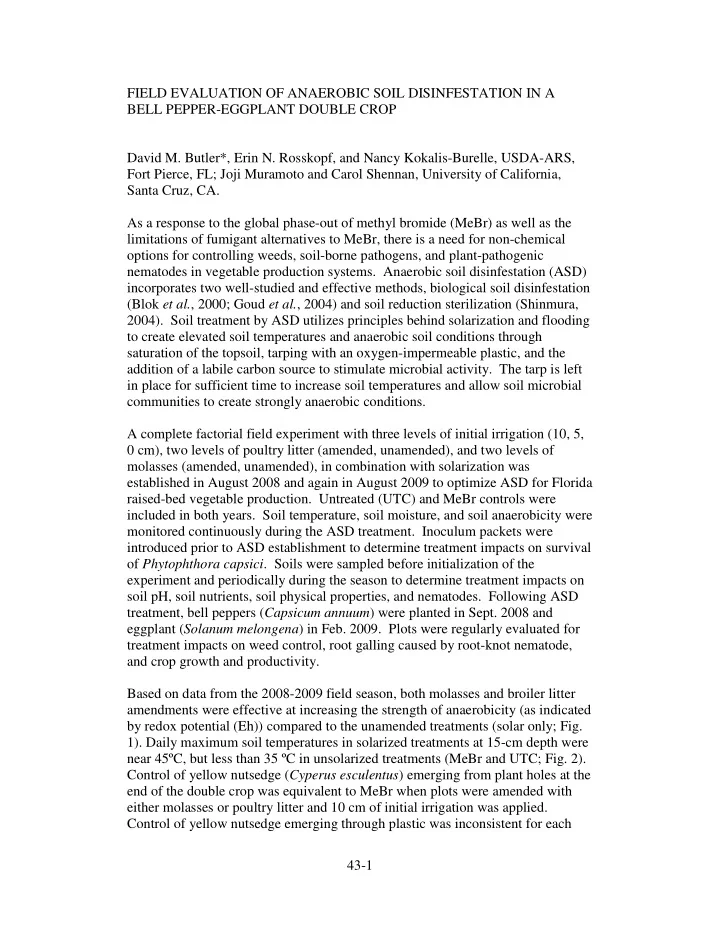

FIELD EVALUATION OF ANAEROBIC SOIL DISINFESTATION IN A BELL PEPPER-EGGPLANT DOUBLE CROP David M. Butler*, Erin N. Rosskopf, and Nancy Kokalis-Burelle, USDA-ARS, Fort Pierce, FL; Joji Muramoto and Carol Shennan, University of California, Santa Cruz, CA. As a response to the global phase-out of methyl bromide (MeBr) as well as the limitations of fumigant alternatives to MeBr, there is a need for non-chemical options for controlling weeds, soil-borne pathogens, and plant-pathogenic nematodes in vegetable production systems. Anaerobic soil disinfestation (ASD) incorporates two well-studied and effective methods, biological soil disinfestation (Blok et al. , 2000; Goud et al. , 2004) and soil reduction sterilization (Shinmura, 2004). Soil treatment by ASD utilizes principles behind solarization and flooding to create elevated soil temperatures and anaerobic soil conditions through saturation of the topsoil, tarping with an oxygen-impermeable plastic, and the addition of a labile carbon source to stimulate microbial activity. The tarp is left in place for sufficient time to increase soil temperatures and allow soil microbial communities to create strongly anaerobic conditions. A complete factorial field experiment with three levels of initial irrigation (10, 5, 0 cm), two levels of poultry litter (amended, unamended), and two levels of molasses (amended, unamended), in combination with solarization was established in August 2008 and again in August 2009 to optimize ASD for Florida raised-bed vegetable production. Untreated (UTC) and MeBr controls were included in both years. Soil temperature, soil moisture, and soil anaerobicity were monitored continuously during the ASD treatment. Inoculum packets were introduced prior to ASD establishment to determine treatment impacts on survival of Phytophthora capsici . Soils were sampled before initialization of the experiment and periodically during the season to determine treatment impacts on soil pH, soil nutrients, soil physical properties, and nematodes. Following ASD treatment, bell peppers ( Capsicum annuum ) were planted in Sept. 2008 and eggplant ( Solanum melongena ) in Feb. 2009. Plots were regularly evaluated for treatment impacts on weed control, root galling caused by root-knot nematode, and crop growth and productivity. Based on data from the 2008-2009 field season, both molasses and broiler litter amendments were effective at increasing the strength of anaerobicity (as indicated by redox potential (Eh)) compared to the unamended treatments (solar only; Fig. 1). Daily maximum soil temperatures in solarized treatments at 15-cm depth were near 45ºC, but less than 35 ºC in unsolarized treatments (MeBr and UTC; Fig. 2). Control of yellow nutsedge ( Cyperus esculentus ) emerging from plant holes at the end of the double crop was equivalent to MeBr when plots were amended with either molasses or poultry litter and 10 cm of initial irrigation was applied. Control of yellow nutsedge emerging through plastic was inconsistent for each 43-1
factorial treatment, although generally intermediate between MeBr and UTC. Control of P. capsici , introduced as buried inoculum, was equal to that of MeBr for all solarized treatments regardless of applied soil amendments or water. Control of plant-pathogenic nematodes in soil immediately following ASD treatment and prior to planting bell peppers was equivalent to MeBr for all treatments that included amendment with either molasses or broiler litter (Fig. 3). However, in general, numbers of plant pathogenic nematodes present were low at that stage in the trial. Total yields of marketable fruit harvested from the bell pepper crop planted after ASD treatments were greater than the untreated control and equal to the harvest from the MeBr control for all but three treatments. Yields of eggplant exceeded the untreated control for all but four treatments, and in the case of treatments with applied litter or applied litter and molasses, exceeded yields observed from the MeBr control. REFERENCES Blok, W.J., J.G. Lamers, A.J. Termorshuizen, and G.J. Bollen. 2000. Control of soilborne plant pathogens by incorporating fresh organic amendments followed by tarping. Phytopathology. 90 :253-259. Goud, J.K.C., A.J. Termorshuizen, W.J. Blok, and A.H.C. van Bruggen. 2004. Long-term effect of biological soil disinfestation on Verticillium wilt. Plant Disease 88 :688-694. Shinmura, A. 2004. Principle and effect of soil sterilization methods by reducing the redox potential of soil. PSJ Soilborne Disease Workshop Report 22 :2- 12. 43-2
Figure 1. Mean soil temperature at 15-cm depth for solarized (ASD factorial) and unsolarized (MeBr and UTC) treatments Figure 2. Mean daily redox potential (Eh) for 2008 ASD treatments. 43-3
Figure 3. Mean number of plant-pathogenic nematodes in 100 cm 3 soil immediately following ASD treatment (means indicated by symbols † and * are significantly different from the MeBr and untreated controls, respectively). 43-4
Recommend
More recommend